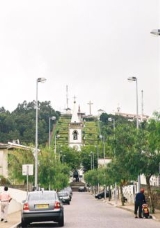
Laundos
Encyclopedia
Laundos or Laúndos is a Portuguese
parish, located in the municipality of Póvoa de Varzim
. In the census of 2001, it had a population of 2,131 inhabitants and a total area of 9.69 km².
The name was first documented in 1033 as Montis Lanutus referring to Saint Félix Hill.
despite its rise, but a Castro village was raised around the 2nd century BC, probably a north surveillance post of Cividade de Terroso
. Ancient Castro jewels were found complete and made its Castro important for the jewel
history of North-western Iberian Peninsula.
This is an ancient parish, existing from time immemorial, as it already existed in the 11th century. The parish belonged to Barcelos until 1836, when it was transferred to Póvoa de Varzim.
to the east, Estela
, Terroso and the municipality of Vila do Conde to the south.
The parish is crowned by São Félix Hill (202 m, 663 ft), the peak of Póvoa de Varzim. Despite the modest rise, the expanse of the plain makes this an easy reference point on the horizon. During the Middle Ages, Saint Félix
would have lived and meditated in this hill, the legends says, he found the body of Saint Peter of Rates from it. The São Félix Hill, in fact, is the best site to see the municipality of Póvoa de Varzim as a whole and is often used for that.
Portugal
Portugal , officially the Portuguese Republic is a country situated in southwestern Europe on the Iberian Peninsula. Portugal is the westernmost country of Europe, and is bordered by the Atlantic Ocean to the West and South and by Spain to the North and East. The Atlantic archipelagos of the...
parish, located in the municipality of Póvoa de Varzim
Póvoa de Varzim
Póvoa de Varzim is a Portuguese city in the Norte Region and sub-region of Greater Porto, with a 2011 estimated population of 63,364. According to the 2001 census, there were 63,470 inhabitants with 42,396 living in the city proper. The urban area expanded, southwards, to Vila do Conde, and there...
. In the census of 2001, it had a population of 2,131 inhabitants and a total area of 9.69 km².
The name was first documented in 1033 as Montis Lanutus referring to Saint Félix Hill.
History
Its arid soil didn’t help in developing an appropriate Castro town like in neighbouring Cividade Hill in the parish of TerrosoTerroso
Terroso is a Portuguese parish located in the municipality of Póvoa de Varzim. In the census of 2001, it had a population of 2,472 inhabitants and a total area of 4.63 km²....
despite its rise, but a Castro village was raised around the 2nd century BC, probably a north surveillance post of Cividade de Terroso
Cividade de Terroso
Cividade de Terroso was an important city of the Castro culture in North-western Iberian Peninsula, located in Póvoa de Varzim, Portugal.The city, known in the Middle Ages as Civitas Teroso, was built at the top of Cividade Hill, in the parish of Terroso, in Póvoa de Varzim, less than 5 km...
. Ancient Castro jewels were found complete and made its Castro important for the jewel
Gemstone
A gemstone or gem is a piece of mineral, which, in cut and polished form, is used to make jewelry or other adornments...
history of North-western Iberian Peninsula.
This is an ancient parish, existing from time immemorial, as it already existed in the 11th century. The parish belonged to Barcelos until 1836, when it was transferred to Póvoa de Varzim.
Geography
Laundos is located 7.5 km east of downtown Póvoa de Varzim in the extreme point of "Póvoa's league" (Légua da Póvoa); and borders RatesRates
Rates is a Portuguese parish and town located in the municipality of Póvoa de Varzim. In the census of 2001, it had a population of 2,539 inhabitants and a total area of 13.88 square kilometres.-History:...
to the east, Estela
Estela
Estela is a Portuguese parish, located in the municipality of Póvoa de Varzim. In the census of 2001, it had a population of 2,596 inhabitants and a total area of 11.73 km²....
, Terroso and the municipality of Vila do Conde to the south.
The parish is crowned by São Félix Hill (202 m, 663 ft), the peak of Póvoa de Varzim. Despite the modest rise, the expanse of the plain makes this an easy reference point on the horizon. During the Middle Ages, Saint Félix
Saint Félix
Saint Felix the Hermit was a 9th century fisherman and hermit, who is venerated as a saint in Portugal.-Legend:Felix was from Villa Mendo, an ancient Roman villa that was rediscovered in the 20th century, having been buried under sand dunes in Póvoa de Varzim, Portugal. Felix could catch no fish,...
would have lived and meditated in this hill, the legends says, he found the body of Saint Peter of Rates from it. The São Félix Hill, in fact, is the best site to see the municipality of Póvoa de Varzim as a whole and is often used for that.

